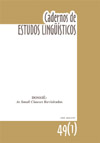Resumo
This paper aims mainly at investigating if there is the formation of resultative constructions with simple adjective in Brazilian Portuguese, since researchers disagree on the existence of these constructions in Romance Languages. To start this discussion, first I make a distinction between resultative, depictive and circumstantial constructions. Then, I relate some of their main characteristics, testing how they appear in sentences written in Brazilian Portuguese. Afterwards, I propose an extension of Folli and Ramchand (2001)’s analysis on the Portuguese. These authors use a structure of verb phrase that consists of three different projections, each one consisting in a subpart of the event: Cause, Process and Result. My hypothesis about the Brazilian Portuguese is that the verbs of causative alternation – as they imply change of state – are the head of Result projection and have as their complement an adjective small clause (SC), whose predicate indicates the telic aspect of event, forming a resultative construction. Following this perspective of analysis, I study the possibility of formation of adjective resultatives with atelic and telic verbs that admit causative alternation. I also approach – although briefly – other types of constructions that express results, whose secondary predicates are, respectively, a complex adjective phrase, a PP or a DP. In this paper, only the constructions resulting from verbal actions are considered. Thus, goal of motion constructions – in which prepositions indicate the following of movement and its ending – and resultative constructions with causative verbs are not considered. The results show that there are not resultative constructions in the Brazilian Portuguese equivalent to those found in Germanic Languages, in which an atelic verb becomes a telic verb by adding a resultative secondary predicate to the sentence.Referências
FOLLI, R.; HARLEY, H. (2006). Consuming results in Italian and English: flavors of v. Disponível em: http://dingo.sbs.arizona.edu/~hharley/PDFs/Papers.html#Folli Consuming Results. Acesso em: 04 ago.
FOLLI, R.; RAMCHAND, G. (2006). Prepositions and Results in Italian and English:an analysis from event decomposition. Disponível em: http://www.hum.uit.no/a/ramchand/rdownloads/folliramfin.pdf. Acesso em: 04 ago.
FOLTRAN, M. J. (1999). As Construções de Predicação Secundária no Português do Brasil: aspectos sintáticos e semânticos. Tese de Doutorado. São Paulo.
FONTANALS, J. M. (2000). Why Can’t We Wipe the Slate Clean? A Lexical-Syntactic Approach to Resultative Constructions. Catalan Working Papers in Linguistics. v. 8, p. 71-95.
ILARI, R. (2006). Expressão do resultado e construções resultativas numa reflexão de Lúcia Lobato. GEL.
KRATZER, A. (2006). Building Resultatives. Disponível em: http://semanticsarchive.net/Archive/GY4ZThjZ/Building%20Resultatives.pdf Acesso em: 15 ago.
LEVIN, B.; RAPPAPORT-HOVAV. (1995). Unaccusativity: at the syntax lexical-semantics interface. Cambridge MA: MIT Press.
LOBATO, L. (2004). Afinal, existe a construção resultativa em português? In: Lígia Negri, Maria José Foltran, Roberta Pires de Oliveira (org.). Sentido e significação: em torno da obra de Rodolfo Ilari. São Paulo: Contexto. p. 142-180.
ROTHSTEIN, S. Verb Classes and Aspectual Classification. Disponível em: http://www.blackwellpublishing.com/content/BPL_Images/Content_store/Sample_chapter/1405106670/ Rothstein_001.pdf
VENDLER, Z. (1967). Verbs and Times. In Z. Vendler. Linguistics in Philosophy. NY: Ithaca, p. 97-121.
WECHSLER, S. (2006). Resultatives Under the ‘Event-Argument Homomorphism’ Model of Telicity. Disponível em: http://uts.cc.utexas.edu/~wechsler/. Acesso em: 15 ago.
O periódico Cadernos de Estudos Linguísticos utiliza a licença do Creative Commons (CC), preservando assim, a integridade dos artigos em ambiente de acesso aberto.

